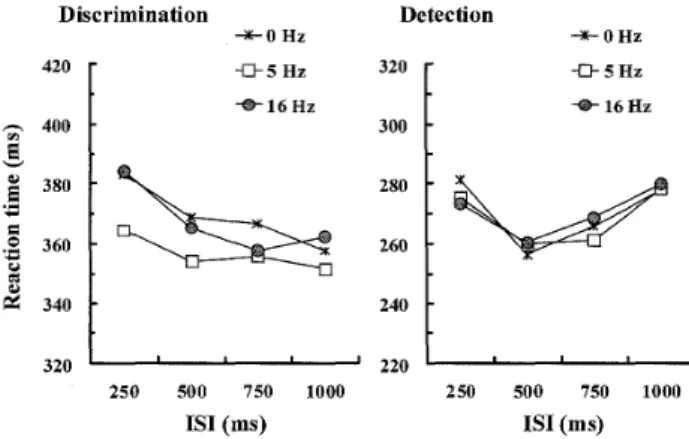The Japanese Psychonomic Society
NII-Electronic Library Service
The JapanesePsychonomic Society
ThekpanesefournalofPsl)chonomieScience
2009,VoL 28,Ne.1,179-180
Summary
ofAwardedPresentation2P55
Effects
of
whole-body
vibration
Kazuma
onvisual
information
processing
IsHiMATsu*,
Nobuyuki
SHiBATA*,
andSetsuo
iVtitionat
institute
of
OccuPational
Sdety
andHealth,
JllPan*MAEDA*
The
present studyinvestigated
whether visualinformation
processingdeteriorates
during
exposure towhole-body vibration
(WBV}.
It
focused
on thefrequency
effects of the vibration ontargetcolor discrirninationand target detection performance. Eight participantsperformed target
color
discrimination
andtarget
detection
tasks
with, and without,5
}Iz
and16
Hz
sinusoidalvertical vibration at a rnagnitude of
1.0
ms 2 r.m.s" Their reaction times(RTs)
as a function ofinter-stimulusintervals
(ISIs)
between a fixationdisplay and a targetdisplay were compared forthreeexperimental
blocks:
baseline
without vibration(O
Hz);
5
Hz
vibration; and16
Hz
vibration.In
the target
diserimination
tasks theRTs
during
shorterISIs
in
the 5Hz block were significantlybrieferthan during the
O
Hz and 16Hzblocks.
For
target
detection,
onthe
otherhand,
nosignificant differencewas found between the threeexperimental
blocks,
These
resu]ts suggestedthat visual information processing
(i.e.
target color discrimination) could be improved during exposure to5Hz sinusoidal vertical WBV,Key
words: whole-body vibration. vibrationfrequency,
targetcolor discrirninationVisual information processing isaffected by noise,
vibration, temperature, and other environmental
fac-tors,A few studies have addressed the issueof
whole-body vibration
(WBV)
on visual informationprocess-ing
(e.g.
Hopcroft & Skinner, 2005;).Although thegeneral
finding isthat vibration producesdecre-ments in
performance,
the stages of inforrnationprocessing
affected by WBV are controversial. Itcould
be
due
todifferencesof vibration frequency ormagnitude which have been used
in
the previousstudies. The purpose of thisstudy was to investigate
the effects of WBV on target detection and discrimi-nation. To thisend, performance during exposure to
5 Hz or 16Hz vibration was compared tothat of a
baseline condition without vibration.
Methods
Participants.
Eight
experimentally naive,right-handed
university students, rangingin
agefrom
21to
23
years<,M=21.9
years}were paid partlcipanLs.All
had
vision which was self-reported as norrnal orcorrected-to-normal, and without color vision
de-fects.
All
participantsgave written inforrnedconsentbeforetaking part inthisstudy, which was approved
by
the appropriate research ethics comrnittees.*Department of Research Planning and
Coordi-nations, National,Institute
Occupational
Safety
and Health,
Japan,
6--21-1
Tama-ku,
Kawasaki
214-8585
Copyright 2009. The JapanesePsychenomic Society. Allrights reservcd.
NII-Electronic Mbrary
Apparatus.
The
stimuli were presented on a22-inch color monitor with a resolution of
512
pixels×512 pixelsand a frame rate of
100
Hz.
A
colorAV-tachistDscope controlled timing of the events,
gener-ated the stimulL and recorded the reaction times
(RTs},
Each participant was tested in adimly
lit
room. The monitor was located at eye level,
approxi-mately 120 cm from the participant.
A
vibrator wasused to generate sinusoidal vertical vibration at a
magnitude of 1.0m$-2 r.m.s.
(unweighted
accelera-tion).
StirnulL
For
fixation,
a white centraldot
wasdis-played on a
black
background.
The
target wasdis-played as a central red or green spot
(1.0
deg.
in
diameter).
Proeedure. The participants performed two
types
oftask:
target
colordiscrimination
and target detection,7largetcolor discriminationtash:
At
the
beginning
of each trialthe fixation
display
was presentedfor
l,OOO ms. The fixationdot was then removed.
After
an inter-stimulus interval
CISIs=250,
500, 750, or1,OOO
rns)a targetdisplay was presented for leO ms,The participants were
instructed
torespond tothetarget as. quickly and accurately as possible
by
press-ing
one of twe keys assigned toa color. The RTs andresponses were recorded.
One
experimental blockconsisted of 112 trials.Each participant performed
the task during each of the fol]owing three
The Japanese Psychonomic Society
NII-Electronic Library Service
The JapanesePsychonomic Society
180 The
Japanese
Journal
oi Psychonornic Science Vol.28,No. Ivibration
(O
Hz);
ablock
with5
Hz
vibration; and ablock
with16
Hz
vibration.
Target
detection
task:The
triaLprocedures were thesame as those
for
the target colordiscrimination
task,with two exceptions.
First,
28
catch tria]sin
which a target was not presented were included.
Thus, one experimental
block
consisted of 140 trials.Second,
only one responsekey
was used.Half
of theparticipants
started with threeblocks
of the targetcolor discrirriinationtask,and the Qther ha]fstarted
with three
blocks
of the targetdetection
task.In
eachtask,the order of perforrning the
blocks
wasrandom-ized
among theparticipants.At
theend of eachblock
each participant reported arating ofdiscomfort
from
the WBV
(from
1,not uncornfortable to 5,veryun-comfortable) as well as a confidence inthe accuracy
of theirresponses
(from
O,cornpletely unconfident to100,completeLy confident).
Results
andDiscussion
R11s:
All
trialsduring
whjch participantshad
madean
incorrect
response, and alltrialsin
which anRT
was
]ess
than100
ms or greater than2.5
standarddeviations
frorn
the rneanRT,
were removedfrom
the analyses. The
RTs,
as afunction
of experirnentalblock and
ISL
are shownin
Figure
1.
An
ana]ysis ofvariance
(ANOVA)
was perforrned on theRTs
with experimentalblock
(O,
5,
16Hz) andISI
(250,
500,
750, and
1,OOO
ms) as within-subject variables.In
thetarget color
discrimination
task,a rnain effect ofISI
and an
interaction
between
experimenta]block
andISI
were significant,F(3,
2l)
:=6.66,
P=.O025
andFC6,
42)=t 2.40,
p=.0439,
respectively.The
main effect ofexperimental
block
was not significant(P
=,.2443).
A
post-hoc
Tukey's
HSD
tcstrevealcd that,inthe 250ms
ISI,
theRT
in
the5
Hz
block
was significantly lessLhan
during
theO
Hz and the 16Hzblocks.
Inthe 500ms ISL the RT inthe 5Hz block was significantly less
than
that during the OIIzblock.There was nosig-nificant differenceof RTs
during
the OHz
and the16
Hz
blocks.
Furthermore,
in
the5
Hz
block
significantISI
effects were not observed. Inthe targetdetectiontask,the RT$ were not significantly dfferent
for
thethree experimental
blocks.
Discomfort
and co?ijZdence:Thc
mean ratings ofdiscomfort and the confidence ratings are listedin
Tablc ]
.
The discomfort was worstin
the 5Hz
block,
and leasLinthe OHz block,The confidence ratLng
for
D;scrimination 420A -)Oopg: jso'eS S60iet 340 +OHn beteetion 3203eo2SOrm240 +OHz 320 220 !50 SOO 7S{; 1000 2S] 500 T50 1000 ISI(ms) ISI(ms)
Figure 1. RTs for the target color
tion task
(left)
andfor
the targetdetection
task
(righO
Table
1
The
ratings ofdiscomfort
and confidence.'
Djscrimination Detection't.OHz5Hz.T16HzOHz'
'5I・{zl16I'Iz Discomfort1,O{O.4)3"g(1.0)2.3(O.7)i1.0(o.o)3.11i2.1'(O.8)(O.6)Confidence81,9C16.0)79.5(15.2)82.4i-86.6
(19.0)(20.0)83,8(l7.5)83,1{22,2)
Arote.
Standard
deviations
of the mean are showninparentheses.
the three
blocks
was not signjficantlydifferent,
The
present study revealed that performance ofvisual targetcolor discriminationwas improved
dur-ing
the5
Hz
WBV.
The
rating of worstdiscornfort
during
the5
Hz
bleck
mightbe
attributablefor
this
improvement.
One
possible explanatien isthat,
to
maintain an appropriate performance
level
during
the unpleasant 5Hz WBV, an arousal levelorreadi-ness forthe appearance of the target might be
in-creased. Further investigation wil] be required to
demonstrate ifthe 5 Hz WBV itselfhas a positive
effect on the response selectien stage of visual
infor-mation processing,
But
contrary to carLier findings,theprescnt study has suggested thatvisual
Lnforma-tion
processing(Le.
target color discrimination)could be improved
during
5Hz sinusoidal verticalvibration.
References
